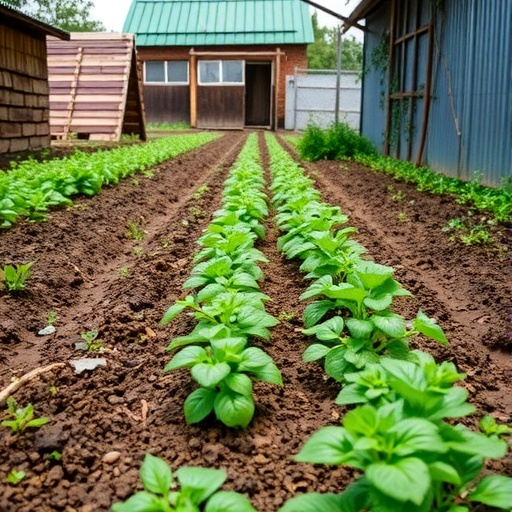In recent years, urban agriculture has gained traction as a sustainable approach to food production, especially in sprawling cities. However, this form of cultivation is not without risks, particularly regarding heavy metal contamination. A groundbreaking study conducted in Nairobi, Nairobi has shed light on the severe consequences of urban farming in areas where heavy metals are prevalent. These findings highlight a pressing public health concern for urban dwellers who depend on locally grown produce.
Heavy metals are naturally occurring elements that can be toxic in high concentrations. Urban environments often exacerbate their prevalence due to industrial activities, vehicular emissions, and improper waste disposal. When it comes to urban agriculture, these environmental contaminants can seep into the soil, thereby entering the food chain. The implications of these findings are particularly alarming for communities with limited access to nutritional food sources.
The study carried out by Murphy, Wachira, Onyango, and their colleagues assessed the levels of heavy metals in various crops cultivated in Nairobi. Concentrations of metals such as lead, cadmium, and arsenic were measured in the fruits and vegetables identified in urban plots throughout the city. Surprisingly high levels were detected, revealing an alarming trend that raises questions about food safety and public health.
In their research, the scientists meticulously sampled crops from different neighborhoods, encompassing a diverse range of farming practices. These areas are characterized by varying degrees of urban pollution, and the findings indicate a correlation between proximity to industrial zones and the concentrations of heavy metals in the produce. This reinforces the urgent need for policymakers to address environmental health risks associated with urbanize food production systems.
As part of the investigation, the researchers also analyzed soil samples, pinpointing the origins of heavy metal contamination. Their results indicate that contaminated irrigation water and industrial runoff are significant factors contributing to soil and crop toxicity. This reinforces the importance of monitoring water sources, as many urban farmers rely on what is available without knowing its safety.
Furthermore, the study emphasizes the urgent need for public awareness and education regarding the risks associated with urban agriculture. Many urban farmers are unaware that the soil or water they are utilizing may contain harmful contaminants. Without proper knowledge and testing, farmers and communities remain vulnerable to health risks resulting from consuming contaminated produce.
Even more unsettling is the fact that the populations most affected by heavy metal contamination are typically the ones least equipped to respond. Child development, prenatal health, and overall well-being can be significantly impacted by exposure to toxic metals. Therefore, the research serves as a call to action for health authorities and community organizations to respond urgently with educational programs and testing initiatives that safeguard urban agriculture.
Despite its alarming findings, the study offers potential pathways for remediation. One promising approach identified by the researchers includes introducing bioremediation strategies that utilize plants known for their capabilities to extract heavy metals from the soil. These methods can reduce toxicity while simultaneously promoting environmental health and sustainability.
In light of the study’s conclusions, there is also a crucial role for testing protocols. The researchers advocate for the implementation of comprehensive testing frameworks for both soil and produce to ensure safety standards are upheld. This proactive measure can help discerning consumers make informed decisions about the origins of their food.
The research also underscores the necessity of collaboration between government, academic institutions, and local farmers. Creating supportive policies that encourage safe farming practices can help mitigate risks associated with urban agriculture. Implementing strict regulations on industrial emissions and waste disposal can effectively reduce soil contamination.
In summary, the findings from Nairobi not only expose serious dangers associated with urban agriculture but also underline the need for systemic change in how urban farming is approached. As cities continue to grow, addressing these environmental health risks is paramount. It offers a critical lens on how urban landscapes must transform to prioritize public health while sustaining food production efforts.
As urban agriculture becomes an increasingly integral part of city living, we must address the challenges it presents with diligence and urgency. The heavy metal contamination study serves as a reminders that the solutions lie within our reach, yet the collective responsibility to advocate for safer farming practices remains essential. As individual consumers and community members band together, they can strive for a future where urban agriculture flourishes without compromising health.
In conclusion, the study conducted in Nairobi is a wake-up call that should resonate across urban centers worldwide. The implications of heavy metal contamination not only question the safety of urban produce but also emphasize the urgent need for a paradigm shift in how we perceive and manage urban agriculture. By embracing sustainable practices and rigorous testing, we can work toward a safer, healthier urban environment for generations to come.
Subject of Research: Heavy metal contamination in urban agriculture in Nairobi.
Article Title: Heavy metal contamination in urban agriculture: evidence from Nairobi.
Article References:
Murphy, M., Wachira, G., Onyango, C. et al. Heavy metal contamination in urban agriculture: evidence from Nairobi.
Environ Sci Pollut Res (2025). https://doi.org/10.1007/s11356-025-37030-x
Image Credits: AI Generated
DOI:
Keywords: heavy metals, urban agriculture, food safety, environmental health, public health, Nairobi, pollution, bioremediation, soil contamination, irrigation water.




